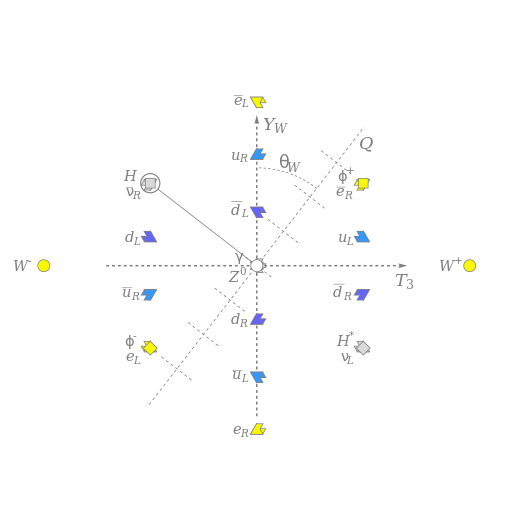The weak hypercharge in particle physics is a quantum number relating the electric charge and the third component of weak isospin. It is conserved (only terms that are overall weak-hypercharge neutral are allowed in the Lagrangian) and is similar to the Gell-Mann–Nishijima formula for the hypercharge of strong interactions (which is not conserved in weak interactions). It is frequently denoted YW and corresponds to the gauge symmetry U(1).[1]
Definition
Weak hypercharge is the generator of the U(1) component of the electroweak gauge group, SU(2)×U(1) and its associated quantum field B mixes with the W3 electroweak quantum field to produce the observed Z gauge boson and the photon of quantum electrodynamics.
Weak hypercharge, usually written as YW, satisfies the equality:
\( \qquad Q = T_3 + {Y_{\rm W} \over 2} \)
where Q is the electrical charge (in elementary charge units) and T3 is the third component of weak isospin. Rearranging, the weak hypercharge can be explicitly defined as:
\( \qquad Y_{\rm W} = 2(Q - T_3) \)
| left-handed | el. charge Q |
weak isospin T3 |
weak hyper- charge YW |
right-handed | el. charge Q |
weak isospin T3 |
weak hyper- charge YW |
|
|---|---|---|---|---|---|---|---|---|
| Leptons | ν e, ν μ, ν τ |
0 | +1/2 | −1 | Do not interact (if exist at all) | |||
| e−, μ−, τ− | −1 | −1/2 | −1 | e− R, μ− R, τ− R |
−1 | 0 | −2 | |
| Quarks | u, c, t | +2/3 | +1/2 | +1/3 | u R, c R, t R |
+2/3 | 0 | +4/3 |
| d, s, b | −1/3 | −1/2 | +1/3 | d R, s R, b R |
−1/3 | 0 | −2/3 | |
Note: sometimes weak hypercharge is scaled so that
\( \qquad Y_{\rm W} = Q - T_3 \)
although this is a minority usage.[2]
Hypercharge assignments in the Standard Model are determined up to a twofold ambiguity by demanding cancellation of all anomalies.
Baryon and lepton number
Weak hypercharge is related to baryon number minus lepton number via:
\( X + 2Y_{\rm W} = 5(B - L) \, \)
where X is a GUT-associated conserved quantum number. Since weak hypercharge is also conserved ] this implies that baryon number minus lepton number is also conserved, within the Standard Model and most extensions.
The pattern of weak isospin, T3, and weak hypercharge, YW, of the known elementary particles, showing electric charge, Q, along the Weinberg angle. The neutral Higgs field (circled) breaks the electroweak symmetry and interacts with other particles to give them mass. Three components of the Higgs field become part of the massive W and Z bosons.
Neutron decay
n → p + e− + νe
Hence neutron decay conserves baryon number B and lepton number L separately, so also the difference B − L is conserved.
Proton decay
Proton decay is a prediction of many grand unification theories.
p+ → e+ + π0 → e+ + 2γ
Hence proton decay conserves B − L, even though it violates both lepton number and baryon number conservation.
See also
Standard Model (mathematical formulation)
Notes
J. F. Donoghue, E. Golowich, B. R. Holstein (1994). Dynamics of the standard model. Cambridge University Press. p. 52. ISBN 0-521-47652-6.
M. R. Anderson (2003). The mathematical theory of cosmic strings. CRC Press. p. 12. ISBN 0-7503-0160-0.
Retrieved from "http://en.wikipedia.org/"
All text is available under the terms of the GNU Free Documentation License


